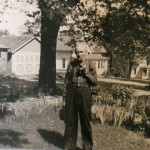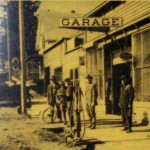by Harold William Thorpe and Karyn Saemann
Be sure to check out the historical photo gallery at the end of this article.
In Giddyap Tin Lizzie, Will O’Shaughnessy, a descendant of Irish immigrants, holds fast to his ethnic heritage while experiencing the great societal upheavals of early 20th-century America. This award-winning book is available through Amazon, the publisher Little Creek Press, and many local bookstores. You can also download a sample chapter today.
They were so close.
It was the second week of December, 1852.
Anna and Richard Fitzsimons headed northwest out of Chicago, on the final leg of a 4,000-mile ocean and overland journey from their native, famine-torn, Ireland. Seven of their eight children were in tow, the youngest just five years old.
The team and wagon waded through deep snow in a winter that, historical records show, was bitterly cold and snowier than normal. With no moon, only the stars led their way. Knowing they would soon celebrate Christmas in their new home in Iowa County, Wisconsin, kept them going.
Richard, though, was sick, with a deep, wracking cough that left him unable to catch his breath. And at a small roadside inn just ten miles out of Mineral Point, tragedy struck.
He died of pneumonia, leaving Anna to finish the journey. She did, single-handedly, raising their children on a farm near Mineral Point that they had bought before leaving Ireland.
1.2 million Irish immigrants
Richard and Anna, my great-great-grandparents, were among an estimated 1.2 million immigrants who entered the United States from Ireland between 1847 and 1854. The flood peaked in 1851, with 221,000 Irish immigrants entering the U.S. that year.
Richard and Anna’s grandson — my grandfather – William Fitzsimons, born in 1869 in Iowa County, was the inspiration for Will O’Shaughnessy in my O’Shaughnessy Chronicles novels.
Why did the Irish leave their homeland? Because of potatoes – or rather, a derth of them. Their potatoes, the main source of food for millions of poor farmers, had rotted on the vines. The blight that devastated Ireland’s potato crop beginning in 1845 had led, by 1850, to more than one million Irish citizens dying of starvation or disease.
The lucky ones found their way to America.
Ireland was the top place of birth for foreign-born U.S. citizens in both the 1850 and 1860 censuses, with about as many immigrants as from Germany and Great Britain — combined.
Those who fled to the U.S. typically sought economic opportunity here, a place to raise their children free from the specter of starvation.
“The Irish came here because they were hungry,” says Janette Hartman, curator at the Iowa County Historical Society.
But many also sought religious and political freedom.
They were banished
Newlyweds Hugh and Margaret McNeill immigrated to America from County Antrim, Ireland, in the 1840s, after being disowned by both of their families. Hugh was Irish protestant, Jane Scotch Catholic; their union was deeply disapproved of by their parents.
“They were banished. It was as if they had died,” says their great-grandson, Bob McNeill, who grew up in Iowa County.
Hugh and Margaret bought a farm near Hollandale in 1848. In the town of Waldwick, on a road that still bears their name – McNeill Road – they built a rock farmhouse that remains standing today. Descendants went on to farm there for generations. The house, sold about ten years ago by the McNeill family, is now privately owned.
Willing to Work
First-generation American citizens had to support themselves financially. And work they did. Many found jobs in the mines that dotted southwest Wisconsin. Some, like John Ross, who arrived in Iowa County in 1839 from County Tyrone, Ireland, became successful enough to own mines. Many farmed. Still others became teachers, doctors, and merchants.
Most came in the wake of the Irish Potato Famine. But some had come to Iowa County before then. Patrick O’Meara, an Irish peddler, is credited with discovering lead in 1827 in Linden, a tiny community which went on to play a key role in the development of the area’s lead mining industry. Until 1855, Linden was known as Peddler’s Creek, after O’Meara.
Others came decades later.
Looking for Opportunity
 Daniel McGraw – McGrath until he passed through Ellis Island – was born in County Antrim, Ireland. In November 1900, at the age of 23, with twenty-five dollars (about $700 today) in his pocket, he and a friend steamed out of Scotland, toward America.
Daniel McGraw – McGrath until he passed through Ellis Island – was born in County Antrim, Ireland. In November 1900, at the age of 23, with twenty-five dollars (about $700 today) in his pocket, he and a friend steamed out of Scotland, toward America.
Daniel told only one sister he was leaving. The day he forever turned his back on Ireland, he told his mother he was going out to buy a magazine. His reasons for that deception have been lost to time, but his motivation for leaving is pretty clear. He was from a poor family and likely foresaw little chance, in his home country, of improving his lot.
“He was looking for opportunity,” believes McGraw’s grandson, Tom McGraw.
In America, he first found work in Philadelphia and then at a foundry in South Beloit, Ill. Finally, with some experience as a mason, he was hired to help finish the steeple on St. Marys (German) Catholic Church in Mineral Point. The church was completed in late December 1901, in time for Christmas mass.
Daniel and his wife, Mary, wed in 1904. They went on to have eleven children and forty-eight grandchildren, and to successfully farm in Iowa County. Today, their descendants still own and operate more than a dozen area farms.
Tom McGraw has visited his grandfather’s birthplace and has set rocks from there into a fireplace mantel at his home in the town of Ridgeway. The McGraws, in recent decades, have connected with distant relatives in Ireland. And in honor of the family’s history, Tom McGraw’s three young sons are named Declan, Dylan, and Aidan.
“It’s important to have those names, to keep our Irish heritage alive,” McGraw explains.
Irish immigrants who settled in Iowa County didn’t have to look far to find kindred souls.

Daniel and Mary McGraw, believed taken in Iowa County on their wedding day, Aug. 3, 1904. Courtesy Diane McGraw.
Irish in Wisconsin
Historically, the Irish-born population in Wisconsin was mostly concentrated in the southern third of the state, south and east of line running roughly from Crawford County to Outagamie County. In 1870, there were particularly heavy pockets in Lafayette, Rock, Walworth, Racine and Milwaukee counties. The concentration of full-blooded Irish-Americans in this part of the state remained high for the next several generations, as they were a tight-knit group, tending to marry others of Irish descent.
“Irish families stuck together,” said John McSherry, whose great-grandmother, Bridget Coyle McSherry, gave birth to her fourth child, Patrick, during the Atlantic crossing from Ireland in 1850. Bridget and her husband, Philip McSherry, were from County Cavan, Ireland. They went on have six more children and to farm in the Ridgeway area.
John McSherry’s parents, Mac and Nora, were married in the 1930s at St. Bridget Catholic Church in Ridgeway.
The concentration of Irish descendants in southern Wisconsin – including Iowa County – had held steady for a century and a half.
In the 1900 U.S. census, up to 15 percent of Wisconsin residents living south of a line stretching roughly from Lacrosse to Fond du Lac identified themselves as foreign-born from Ireland, compared to less than five percent for most the rest of the state, where German, Norwegian and other nationalities prevailed. Lafayette, Rock, and Walworth counties in southern Wisconsin were the hot pockets of Irish heritage in 1900, with up to 25 percent of residents claiming to be foreign-born from Ireland.
Wisconsin, in general, was a hot pocket for immigrants in 1900. In ranked sixth in the nation in foreign-born residents in the 1900 U.S. census, surpassed only by Michigan, Massachusetts, Illinois, Pennsylvania and New York. In 1900, Wisconsin’s number of Irish-born residents ranked thirteenth among U.S. states, with about a 25,000 people of Irish ancestry.
A century later, in the 2000 U.S. census, more than 10 percent of those living in an area south and west of a line stretching roughly from Lacrosse to Elkhorn still claimed Irish ancestry. Lafayette, Crawford, Richland – and Iowa — counties in southwest Wisconsin remained Irish hot pockets in 2000, with more than 15 percent of residents claiming Irish ancestry.
Statewide in the 2000 census, eleven percent of Wisconsin residents claimed Irish heritage, second only to German (43 percent) and surpassing Polish (9 percent), Norwegian (8.5 percent) and English (6.5 percent).
Irish in the U.S.
And nationwide in the 2000 U.S. census, about 30 million people, or 11 percent of the population, claimed to be of Irish heritage. That was second only to German (43 million) and surpassed African-American (25 million), English (25 million), Mexican (18 million), Italian (16 million), Polish (9 million) and American Indian (8 million).
Religion

Stained glass at St. Philip Catholic Church, Highland. ©2015 Inkspots, Inc.
The descendants of Iowa County’s nineteenth-century Irish immigrants grew up amid a strong Irish and usually, but not always, Catholic influence.
Irish Catholics in Iowa County built a slew of church buildings, including St. Bridget in Ridgeway; St. Philip in Highland; St. Pauls in Mineral Point; St. Joseph’s in Dodgeville; and St. Patrick in Hollandale.
The stained glass windows at St. Philip still bear inscriptions of the names of those who donated money to install them.
The old sections of these churches’ cemeteries help tell the area’s Irish immigration story. Some of the oldest inscriptions are in Gaelic. They tell, for instance, about Patrick Delaney, buried in the St. Phillip Cemetery in Highland. In 1843, at age 31, he came to America from Queen’s County, Ireland. He and his wife, Julia, settled in Iowa County in 1846 and went on to raise nine children.
Dozens of Fitzsimonses are buried in Graceland Cemetery in Mineral Point.
The first generation of immigrants laid a strong base that later helped carry Iowa County into the present day. Early Irish settlers contributed significantly to southwest Wisconsin – and statewide – history.
They settled en mass in Iowa County in communities like tiny Highland, current population 842; Hollandale; Ridgeway; and in unincorporated Knobs, in the town of Ridgeway.
Patricia Pailing grew up in Knobs, surrounded by extended family.
“It was all Irish in Knobs,” recalls Pailing, whose grandmother, Hannah Roach Harrington, was born in Iowa County in 1869, fourteen years after her parents and older siblings came from Ireland. Though her grandmother never lived in Ireland, Pailing recalls her writing to distant relatives there.
The first child born in Highland was Irish – Andrew McCready — in 1845.
The first two settlers in the town of Clyde, in the northwest corner of the county, were Irish. John Burns and his family arrived in 1845, followed soon afterward by Michael Murphy.
Signposts of places like Irish Hollow Road, near Highland, hint at the area’s Irish legacy.
Irish names appear prominently on lists of early elected local officials.
And descendants of Iowa County Irish immigrants went on to own lumberyards, hardware stores, drug stores, funeral parlors, and mills. They made their mark working as mail carriers, dentists, carpenters, furniture makers, teachers, saloon operators, grocers, attorneys, house painters, policemen, and of course, farmers.
A year after graduating from Hollandale High School in 1945 — 97 years after his great-grandparents, Hugh and Margaret McNeill, settled in Iowa County — Bob McNeill started an electrical business that is still in operation today.
The Fillback Family of Highland, whose ancestors came to Iowa County from Ireland in the nineteenth century, has run a car dealership — today Ford, Chrysler and GMC — since 1948.

Margaret McGuire, Highland, 1948 Alice in Dairyland. Courtesy Highland Area Historical Society.
First Alice in Dairyland
They’ve been part of historic celebrations. In 1948 – as part of Wisconsin’s centennial — Highland teenager Margaret McGuire was crowned the state’s very first Alice in Dairyland. McGuire’s father, Alphonse, was a mail carrier and barber in Highland, and is remembered as a singer and musician.
Many fought —and some were lost — in foreign wars. Emanuel McGuire, of Highland, was declared missing in action in 1944, during World War II.
Through the twentieth century, they struggled with ethnic and religious divides.
In Hollandale, “You were Irish or Norwegian, you were one or the other,” recalls McNeill. When he was growing up, Catholics and protestants didn’t mix.
“There was a lot of tension,” McNeill recalls. In addition to St. Patrick, Hollandale had two Lutheran churches, one Norwegian and one Swedish. It was not uncommon for business and even land purchase deals to fall through based on ethnic and religious differences.
“Religion was such a big thing. They couldn’t get along,” McNeill says.
But among themselves, the descendants of Iowa County’s Irish relished a common bond.
“They were just fun-loving people. Somebody was always at somebody’s house,” Pailing recalls.
“Everyone would come and play cards, and sing,” recalls Betsy Richgels, who grew up in Highland.
Richgels’ grandfather, Frank Connor, Jr., was a longtime rural mail carrier in Highland. Her great-grandfather, Frank Connor, Sr., settled in Highland in the 1860s; whether he was born in Ireland or soon after his parents arrived in America is unclear. He helped build St. Phillip Catholic Church.
Some tended bar — like John Muldowney, who ran a tavern in Highland in the mid-twentieth century.
“He had a charm about him, and these little rosy cheeks,” recalls Richgels. “And he was always buying everyone drinks. I often wonder how he stayed in business.”
Irish wakes
Richgels also remembers Irish wakes that stretched into all-night parties, and fresh flowers placed into the hair of the departed. “They didn’t believe in mourning the dead. They believed in honoring them.”
They shared a deeply superstitious nature that gave rise to legends like the Ridgeway Ghost and all manner of bump-in-the-night tales.
Corned beef and cabbage, and raucous celebrations including impromptu parades, were typical on St. Patrick’s Day, which was celebrated at taverns and at house parties.
Corned beef and cabbage
In Highland, St. Anthony & Philip parish still celebrates with a traditional corned beef dinner, that’s open to the public. But corned beef and cabbage, was, in fact, not always common fare for second and third-generation Irish Americans. They also sampled and adopted other ethnic influences that surrounded them.
In Iowa County, also home of many Cornish immigrants, that often meant not boxty – a traditional Irish potato pancake – but rather pasty, a traditional Cornish meat and rutabaga pie, on the dinner table.
“Pasties were easy to take to the mines. The Irish jumped on that bandwagon,” McSherry said.
“Oh, yes, my goodness, we always had pasties,” said Pailing. “And saffron bread.”
In Giddyap Tin Lizzie, Will O’Shaughnessy, a descendant of Irish immigrants, holds fast to his ethnic heritage while experiencing the great societal upheavals of early 20th-century America. This award-winning book is available through Amazon, the publisher Little Creek Press, and many local bookstores. You can also download a sample chapter today.
Iowa County Irish Immigrants
Below, arranged by the year they settled in Iowa County, Wisconsin are the county’s early Irish immigrants. All were born in Ireland. If known, listed immediately after their name is their birthplace in Ireland and birth year. The date of their arrival in America is listed next, if prior to their arrival in Iowa County. Finally are listed their spouse’s name, number of children, profession, and other notes of interest.
This list, based on family genealogies and Iowa County Historical Society records, is not all-inclusive. If your ancestors immigrated from Ireland and settled in Iowa County, and do not appear below, please send us their information via email at novels@haroldwilliamthorpe.com. We will be happy to add it.
1836
Gen. James Smith. 1801. America, 1817. Ann McSherry; many children.
1839
John Ross. County Tyrone, 1819. Sarah Sproule; three children. Mine operator.
1840s
Thomas Heffern. County Kilkenny, 1820s. Three sons.
1841
William Walker. 1814. America, 1839. Letitia Gibson; one son. Hotel owner, lead hauler, lime manufacturer.
1842
William Manning. County Kilkenny. America, 1841. Rachel Powers and Katie Griffin; eight children. Farmer.
1843
Mrs. John Muldoon. Donegal, 1825. Thomas Tobias. Widowed, came to America alone with two children. Later, John Muldoon; three children.
1844
Daniel Dornan. County Killavry, 1816. America, 1840. Mary Hughes and Bridget McMahon; three children and two step-children. Farmer.
John Laverty. County Antrim, 1822. Mary Ann Carroll and Nancy McCloskey; eleven children. Farmer.
Francis Little. County Fermanagh, 1822. America, 1842. Farmer, merchant, Wisconsin state senator.
Thomas Manning. 1817. Catherine Gillany; twelve children. Farmer.
Michael Murphy. County Limerick, 1825. Sarah Morton; two children.
1845
Thomas Wallace. County Kilkenny, 1807. Margaret Loy
1846
John Aid, County Kilkenny. Margaret Muldooney; four children. Farmer.
Patrick Delaney. Queen’s County, 1812. America, 1843. Julia Foley; nine children. Farmer
James McCutchin. County Tyrone. America with brother, Andrew, 1842. Jane Gurthie; eight children. Farmer
John McKenna. 1837. America, 1841. Ann McNeil; five children. Farmer.
Francis McKenna. America, 1841. Miner and farmer.
John McWilliams. 1815. America, 1837. Mary O’Kane. Shoemaker
1847
Martin Phelan. County Kilkenny, 1825. Miner
1848
Thomas Maguire. County Monahan. America, 1847. Rose McEntee; one child and two step-children. General store owner and lead miner.
John Phelan. Died in 1852, enroute to California.
Thomas Torphy. County Tippery, 1828. Stone mason, railroad construction, teacher, farmer, justice of the peace. Brothers John and Michael later also settled in Iowa County.
Thomas Wall. County Kilkenny, 1826. Ellen Kent; six children. Farmer.
Hugh McNeill and Margaret Hamil. He was protestant, she catholic. Left Ireland after being disowned by both families, who objected to their marriage. Farmers.
1849
John Ferris. County Down, 1818. America, 1847. Mary Stevens. Miner, farmer.
1850
George Crawford. 1849. Mary White; three children. Iowa County Democrat publisher.
John Cummins. Roscommon, 1819. America, 1849. Mary Corcoran; five children. Teacher.
Patrick Grant. County Kilkenny, 1840. Elizabeth Gunn; four children.
Michael Griffin. 1828. America, 1849. Mary Morris; ten children.
James Kennedy. America, 1840. Coal and zinc miner.
Philip McSherry. 1825, County Cavan. Bridget Coyle, 1824, County Cavan. Ten children – three born in Ireland; one, Patrick, born on-ship during Atlantic crossing; six born in Wisconsin. Farmers.
1852
James Clark. County Calvin, 1813. Nine children. Farmer.
Joseph Conley. America, 1849. Margaret Dewham; nine children. Farmer.
Abraham Ferris. 1827. America, 1849. Elizabeth Fitzsimons; six children. Agriculture implements and farm machinery dealer, stock raising and stock shipping.
Anna Keegan Fitzsimons. Left County Wicklow with husband, Richard Fitzsimons, and seven children, 1852. He died of pneumonia between Belmont and Mineral Point, 1852. Farmer.
Michael Ford. County Kilkenny, 1825. America, 1849. Julia Cody; five children. Farmer.
1854
James McMullan. 1826. America, 1848. Ann O’Neal; eight children. Farmer.
1855
Patrick Brennan. 1827. Five children. Railroad worker.
Thomas Laughlin. County Clare, 1812. America, 1849. Farmer.
Patrick McDonnell. 1817. America, 1837. Mary Sheeren; eleven children. Farmer.
Nicholas and Margaret Roach. He was born in 1821, she in 1829, both County Cork. America, late 1840s with her brother, John Mahoney (born 1828). Eight children, one adopted son. Farmers.
1856
J.C. Eagan. 1844. Mary Claybaugh; three children. Merchant and postmaster.
Thomas Ferry. 1805. America, 1832. Ann Tressa; two children. Blacksmith and farmer.
Cornelius Shelton. County Clare, 1830. America, 1849. C. Fitzpatrick; six children. Farmer
1857
James Cody. America, 1850. Margaret Walsh. Farmer.
1858
Richard Egan. County Kilkenny, 1833. Catherine Murphy; three children. Farmer.
1859
Edward McIlhatton. County Antrim, 1822. America, 1844. Farmer.
1860
Charles Duffy. 1825. America, 1849. Mary Hamilton and Ellen Connell; eleven children. Farmer
1863
John Ross. 1819. America, 1845. Elizabeth Binks; seven children. Farmer.
1865
John McDermott. County Cavan, 1836. America, 1852. Mary Ann Osborn; six children. Farmer.
1866
John Bohan. 1846. America, 1865. Mary Ann Noonan; two children. Livery and mining.
Dennis Lawler. 1828. America, 1847. Catharine Kelley; six children. Farmer.
1867
Thomas Burke. 1823. America, 1845. Mary Kehoe and Mary James; five children. Farmer.
William Lynch. County Longford, 1839. Margaret Farrell; eight children.
1868
William Kinear. Kings County, 1842. America, 1860. Susan Cary. Merchant.
Richard Lane. Queen’s County, 1842. Adele Ranger; five children. Wagon maker.
Bernard McMurrough. 1827. Mary McCarraghan; nine children. Farmer.
1869
Thomas Cody. America, 1850. Six children. Farmer.
Michael McKenne. America, 1841. Mary Eddy; four children. Farmer.
1875
Charles Egan. County Clare, 1854. America, 1849. Katie Kent; one child. Doctor.
1877
D.J. Mulhall. County Wicklow, 1846. America, 1854. C. Doyle; two children. Teacher.
1878
Rev. M Luby. 1846. America, 1851. Pastor at St. Bridget’s Catholic church, Ridgeway.
1881
Thomas Conolly. County Golway, 1844. America, 1864. Annie Donolly; two children. Farmer.
Charles McDonnell. 1858.
1895
John Boyle. New Market, 1867. America, 1876. Anna Wilson; three children. Dodgeville Sun editor.
1901
Daniel McGraw. County Antrim, 1877. America, 1900. Mary Laverty; eleven children. Mason and farmer.
Gallery
- Mac and Nora McSherry wedding, 1930s, St. Bridget Catholic Church, Ridgeway.
- St. Bridget Catholic Church, Ridgeway.
- Margaret McGuire, Highland, 1948 Alice in Dairyland.
- Knobs School, 1903.
- St. Philip Catholic Church, Highland.
- St. Philip Catholic Church, Highland.
- John K. McSherry, of Ridgeway, was a first-generation American born in Iowa County in the 1860s. Three of his siblings were born in Ireland, one was born during his family’s Atlantic crossing from Ireland in 1850, and six, including John, were born in Wisconsin. This photo was taken in Ridgeway in the 1940s.
- St. Bridget Catholic Church, Ridgeway.
- St. Bridget Catholic Church, Ridgeway.
- Dr. Charles Egan came to America in 1854. Beginning in 1875, he lived and practiced medicine in Highland.
- St. Philip Cemetery, Highland.
- St. Philip Cemetery, Highland.
- Irish immigrants Hugh and Margaret McNeill built this rock farmhouse, which still stands today, in the town of Waldwick in 1848.
- Irish Hollow Road, town of Highland.
- Emanuel McGuire, Highland, declared missing in action in World War II.
- Nicholas and Margaret Roach brought their family to Iowa County in 1855, setting in Knobs. Both are buried in St. Bridget Cemetery, Ridgeway.
- Aid’s Garage, Highland, early twentieth century.
- St. Philip Catholic Church, Highland.
- Kennedy Mine, Highland.
- An early twentieth century newspaper ad for the The Cody Store, Highland.
- Fillback Ford, Highland.
- Thomas Torphy came to Iowa County from Ireland in 1848.
- Edward Fitzsimons (second from left, front) was 18 years old when he emigrated with his family from Ireland in 1852. Edward and his wife, Elizabeth (front, third from left), went on to raise eight children in Iowa County.
- McGraw family farm in the town of Ridgeway.
- Knobs Road, town of Ridgeway.
- St. Philip Cemetery, Highland.
- Daniel McGraw left Ireland in 1900. He and his wife, Mary, raised eleven children in Iowa County. This photo was taken in the late 1940s.




































